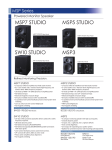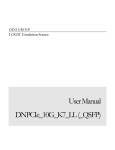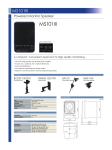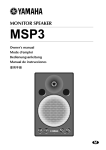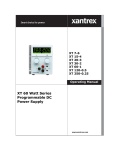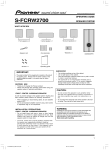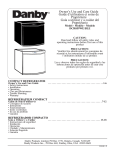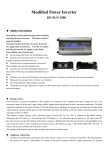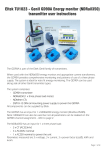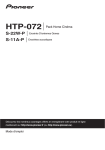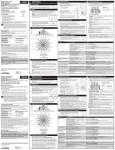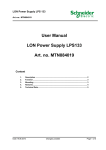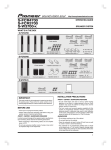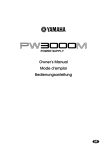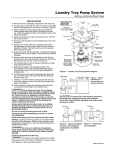Download MSP3_manual - User manual
Transcript
MONITOR SPEAKER MSP3 Owner’s manual Mode d’emploi Bedienungsanleitung Manual de instrucciones LOW HIGH 1 LINE 2 M • Explanation of Graphical Symbols The lightning flash with arrowhead symbol within an equilateral triangle is intended to alert the user to the presence of uninsulated “dangerous voltage” within the product’s enclosure that may be of sufficient magnitude to constitute a risk of electric shock to persons. CAUTION RISK OF ELECTRIC SHOCK DO NOT OPEN The exclamation point within an equilateral triangle is intended to alert the user to the presence of important operating and maintenance (servicing) instructions in the literature accompanying the product. CAUTION: TO REDUCE THE RISK OF ELECTRIC SHOCK, DO NOT REMOVE COVER (OR BACK). NO USER-SERVICEABLE PARTS INSIDE. REFER SERVICING TO QUALIFIED SERVICE PERSONNEL. The above warning is located on the rear of the unit IMPORTANT SAFETY INSTRUCTIONS 1 2 3 4 5 6 7 Read these instructions. Keep these instructions. Heed all warnings. Follow all instructions. Do not use this apparatus near water. Clean only with dry cloth. Do not block any ventilation openings. Install in accordance with the manufacturer’s instructions. 8 Do not install near any heat sources such as radiators, heat registers, stoves, or other apparatus (including amplifiers) that produce heat. 9 Do not defeat the safety purpose of the polarized or grounding-type plug. A polarized plug has two blades with one wider than the other. A grounding type plug has two blades and a third grounding prong. The wide blade or the third prong are provided for your safety. If the provided plug does not fit into your outlet, consult an electrician for replacement of the obsolete outlet. 10 Protect the power cord from being walked on or pinched particularly at plugs, convenience 11 12 13 14 receptacles, and the point where they exit from the apparatus. Only use attachments/accessories specified by the manufacturer. Use only with the cart, stand, tripod, bracket, or table specified by the manufacturer, or sold with the apparatus. When a cart is used, use caution when moving the cart/ apparatus combination to avoid injury from tip-over. Unplug this apparatus during lightning storms or when unused for long periods of time. Refer all servicing to qualified service personnel. Servicing is required when the apparatus has been damaged in any way, such as powersupply cord or plug is damaged, liquid has been spilled or objects have fallen into the apparatus, the apparatus has been exposed to rain or moisture, does not operate normally, or has been dropped. WARNING TO REDUCE THE RISK OF FIRE OR ELECTRIC SHOCK, DO NOT EXPOSE THIS APPARATUS TO RAIN OR MOISTURE. IMPORTANT Please record the serial number of this unit in the space below. Model: Serial No.: The serial number is located on the bottom or rear of the unit. Retain this Owner’s Manual in a safe place for future reference. IMPORTANT THE WIRES IN MAINS LEAD ARE COLOURED ACCORDANCE WITH THE FOLLOWING CODE: BLUE : BROWN : IN NEUTRAL LIVE As the colours of the wires in the mains lead of this apparatus may not correspond with the coloured markings identifying the terminals in your plug proceed as follows: The wire which is coloured BLUE must be connected to the terminal which is marked with the letter N or coloured BLACK. The wire which is coloured BROWN must be connected to the terminal which is marked with the letter L or coloured RED. Making sure that neither core is connected to the earth terminal of the three pin plug. * This applies only to products distributed by YAMAHA KEMBLE MUSIC (U.K.) LTD. 2 Thank you for purchasing the Yamaha MSP3 monitor speaker system. The MSP3 features a compact bass reflex cabinet, with a 10 cm two-way cone speaker and a 2.2 cm dome speaker. This powered bi-amplifier speaker system faithfully reproduces sound and can be used for a wide range of applications, from personal home recordings to serious professional use. Please read this Owner’s Manual thoroughly to make the best use of the MSP3’s quality functions for the longest period of time, and keep the manual in a safe place. Precautions Warning Cautions • Connect this unit's power cord only to an AC outlet of the type stated in this Owner's Manual or as marked on the unit. Failure to do so is a fire and electrical shock hazard. • Do not allow water to enter this unit or allow the unit to become wet. Fire or electrical shock may result. • Do not place heavy objects, including this unit, on top of the power cord. A damaged power cord is a fire and electrical shock hazard. In particular, be careful not to place heavy objects on a power cord covered by a carpet. • Do not insert or drop metal or flammable objects into the port of this unit. Fire or electrical shock may result. • Do not place a container with liquid or small metal objects on top of this unit. Liquid or metal objects inside this unit are a fire and electrical shock hazard. • Do not scratch, bend, twist, pull, or heat the power cord. A damaged power cord is a fire and electrical shock hazard. • Do not modify the unit. Doing so is a fire and electrical shock hazard. • If lightning begins to occur, turn off the power switch of the unit as soon as possible, and unplug the power cable plug from the electrical outlet. • If there is a possibility of lightning, do not touch the power cable plug if it is still connected. Doing so may be an electrical shock hazard. • Do not remove the unit’s cover. You could receive an electrical shock. If you think internal inspection, maintenance, or repair is necessary, contact your dealer. • If the power cord is damaged (i.e., cut or a bare wire is exposed), ask your dealer for a replacement. Using the unit with a damaged power cord is a fire and electrical shock hazard. • If you notice any abnormality, such as smoke, odor, or noise, or if a foreign object or liquid gets inside the unit, turn it off immediately. Remove the power cord from the AC outlet. Consult your dealer for repair. Using the unit in this condition is a fire and electrical shock hazard. • Should this unit be dropped or the cabinet be damaged, turn the power switch off, remove the power plug from the AC outlet, and contact your dealer. If you continue using the unit without heeding this instruction, fire or electrical shock may result. • Keep this unit away from the following locations: – Locations exposed to oil splashes or steam, such as near cooking stoves, humidifiers, etc. – Unstable surfaces, such as a wobbly table or slope. – Locations exposed to excessive heat, such as inside a car with all the windows closed, or places that receive direct sunlight. – Locations subject to excessive humidity or dust accumulation. • Do not place the power cord close to a heater. It may melt, causing fire or electrical shock. • Hold the power cord plug when disconnecting it from an AC outlet. Never pull the cord. A damaged power cord is a potential fire and electrical shock hazard. • Do not touch the power plug with wet hands. Doing so is a potential electrical shock hazard. • When rack-mounting the unit, allow enough free space around the unit for normal ventilation. This should be: 10 cm at the sides, 20 cm behind, and 30 cm above. For normal ventilation during use, remove the rear of the rack or open a ventilation hole. If the airflow is not adequate, the unit will heat up inside and may cause a fire. • A speaker system placed on top of a table may move gradually due to vibration and may eventually fall off the table, causing damage or injury. In such an installation, fix the speaker system to the table and check it occasionally. 3 • To relocate the unit, turn the power switch off, remove the power plug from the AC outlet, and remove all connecting cables. Damaged cables may cause fire or electrical shock. • Turn off all musical instruments, and audio equipment when connecting to this unit. Use the correct connecting cables and connect as specified. • Always lower the volume control to minimum before turning on the power to this unit. A sudden blast of sound may damage your hearing. • Do not output distorted sounds for long periods of time, as this will cause the speaker to heat up, leading to a fire hazard. • Do not raise the volume of speakers to a level that makes you feel uncomfortable. Listening to loud music for long periods can damage your hearing. • If you know you will not use this unit for a long period of time, such as when going on vacation, remove the power plug from the AC outlet. Leaving it connected is a potential fire hazard. • To prevent electrical shock when cleaning the unit, remove the power plug from the AC outlet. • XLR-type connectors are wired as follows: pin 1: ground, pin 2: hot (+), and pin 3: cold (–). • This speaker is magnetically shielded. However, if a nearby monitor displays any uneven colors, place it further away from the monitor. • Using a mobile telephone near this unit may induce noise. If noise occurs, use the telephone away from the unit. 4 Front panel/Rear panel 5 LINE 2 level control This control knob enables you to adjust the volume level of the signal input at one of the INPUT LINE 2 jacks (8) on the rear panel. Turning the knob counterclockwise lowers the volume level, and turning it clockwise raises the level. 6 8 7 POWER INPUT ON LINE 1 (–10dB) OFF LINE 2 (+4dB) PARALLEL LOW HIGH 1 2 1 3 4 LINE 2 5 1 LOW control This control knob enables you to adjust the bass in the range of –3dB to +3dB based on a reference value of 100Hz. The bass range is flat with the knob set at 12 o’clock, boosted when the knob is turned clockwise, and cut when the knob is turned counter-clockwise. 2 HIGH control This control knob enables you to adjust the treble in the range of –3dB to +3dB based on a reference value of 10kHz. The treble range is flat with the knob set at 12 o’clock, boosted when the knob is turned clockwise, and cut when the knob is turned counter-clockwise. 6 POWER switch This switch turns the power to the MSP3 on and off. When you turn this switch on, the power indicator (3) lights up green. 7 INPUT LINE 1 jack This input jack is used to connect an RCA pin plug. 8 INPUT LINE 2 jacks These balanced jacks are used to connect an XLR-3-31 type connector or a TRS phone plug to input line-level signals from a mixing console. 3 Power indicator This indicator lights up green when you turn the POWER switch on the rear panel ON. 4 LINE 1 level control This control knob enables you to adjust the volume level of the signal input at the INPUT LINE 1 jack (7) on the rear panel. Turning the knob counter-clockwise lowers the volume level, and turning it clockwise raise the level. CAUTION TO PREVENT ELECTRIC SHOCK, MATCH WIDE BLADE OF PLUG TO WIDE SLOT, FULLY INSERT. 5 Specifications ● Amp.unit Maximum Output Power ..........20W Input Sensitivity/Impedance LINE 1: –10 dB/10 kΩ (RCA phono, Unbalanced) LINE 2: +4 dB/10 kΩ (XLR, phone Balanced) Level control LINE 1 LINE 2 Tone control HIGH ● Speaker unit LOW Speaker Unit Power Indicator ..........................Green LED LF: 10 cm cone (4Ω, magnetic shielded) Power Requirement HF: 2.2 cm dome (4Ω, magnetic shielded) USA and Canada: .................AC120 V, 60 Hz Enclosure Europe:..................................AC230 V, 50 Hz Type: Bass Reflex Others: ..................................AC240 V, 50 Hz Power Consumption ..................30 W Option ........................................BWS20-190 (Ceiling/ wall Bracket) Specifications and appearance are subject to change without notice. ● General specifications Type............................................ 2-way Bass Reflex Powered Speaker Crossover Frequency ................. 4 kHz Frequency Range ....................... 65 Hz–22 kHz Maximum Output Level ........... 98 dB (1 m on Axis) Dimensions (W × H × D) ......... 144 × 236 × 167 mm Weight ........................................ 4.4 kg Magnetic shielded...................... EIAJ 236 Dimensions LOW 1 HIGH LINE 2 (6) 155 (6) 167 44 144 60 2-M5 Unit: mm 6 Block Diagram LINE 1 LINE 1 HF TONE CONTROL P. AMP LF LINE 2 LINE 2 LOW HIGH Phone Jack Performance graph +10 RESPONSE (dB) 0 –10 –20 –30 –40 20 100 1k 10k FREQUENCY (Hz) 7 MSP3 Mode d’emploi Nous vous remercions d’avoir porté votre choix sur l’enceinte d’écoute Yamaha MSP3. Cette enceinte comporte un coffret bass reflex avec un haut-parleur conique à deux voies de 10 cm et un haut-parleur à dôme de 2,2 cm. Ce système actif bi-amplifié reproduit le son avec une grande fidélité et peut servir à de nombreuses fins, allant des enregistrements à domicile à un usage professionnel sérieux. Veuillez lire attentivement ce Mode d’emploi afin de tirer parti de toutes les possibilités offertes par le MSP3 durant de longues années. Précautions Avertissements • Ne branchez le cordon d’alimentation de cet appareil qu’à une prise secteur qui répond aux caractéristiques données dans ce manuel ou sur l’appareil, faute de quoi, il y a risque d’incendie. • Evitez de mouiller l’appareil ou de laisser pénétrer de l’eau dans son boîtier. Il y a risque d’incendie ou d’électrocution. • Ne posez pas d’objets pesants (à commencer par l’appareil lui-même) sur le cordon d’alimentation. Un cordon d’alimentation endommagé peut provoquer un incendie ou une électrocution. Cette précaution est notamment valable lorsque le cordon d’alimentation passe sous un tapis. • N’insérez pas d’objets métalliques ou inflammables dans les orifices d’aération l’entrée de cet appareil. Il y a risque d’incendie ou d’électrocution. • Ne posez pas de récipient contenant des liquides ou de petits objets métalliques sur l’appareil. Si un liquide ou des objets métalliques pénètrent dans l’appareil, il y a risque d’incendie ou d’électrocution. • Evitez de griffer, tordre, plier, tirer ou chauffer le cordon d’alimentation. Un cordon d’alimentation endommagé constitue un risque d’incendie ou d’électrocution. • N’ouvrez jamais le boîtier de cet appareil. Il y a risque d’électrocution. Si vous pensez que l’appareil doit subir une révision, un entretien ou une réparation, veuillez contacter votre revendeur. • Cet appareil ne peut pas être modifié par l’utilisateur. Il y a risque d’incendie ou d’électrocution. • En cas d’orage, veillez à mettre l’unité hors tension dès que possible et à débrancher le cordon d’alimentation de la prise murale. • En cas d’orage avec des risques de foudre, évitez tout contact avec le cordon d’alimentation si ce dernier est toujours connecté à une prise murale. Vous éviterez ainsi une électrocution. 1 • Si le cordon d’alimentation est endommagé (s’il est coupé ou si un fil est à nu), veuillez en demander un nouveau à votre revendeur. L’utilisation de l’appareil avec un cordon d’alimentation endommagé constitue un risque d’incendie ou d’électrocution. • Si vous remarquez un phénomène anormal tel que de la fumée, une odeur bizarre ou un bourdonnement ou, encore, si vous avez renversé du liquide ou des petits objets à l’intérieur, mettez l’appareil immédiatement hors tension et débranchez le cordon d’alimentation. Consultez votre revendeur pour faire examiner l’appareil. L’utilisation de l’appareil dans ces conditions constitue un risque d’incendie ou d’électrocution. • Lorsque l’appareil tombe ou si le boîtier est endommagé, coupez l’alimentation, débranchez le cordon de la prise secteur et contactez votre revendeur. L’utilisation de l’appareil dans ces conditions constitue un risque d’incendie ou d’électrocution. Français Deutsch • Evitez de placer l’appareil dans les endroits suivants: – Les endroits soumis à des éclaboussures d’huile ou à de la vapeur (à proximité de cuisinières, d’humidificateurs, etc.). – Des surfaces instables, telles un table mal balancée ou une surface inclinée. – Les endroits soumis à une chaleur excessive (à l’intérieur d’un véhicule toutes fenêtres fermées) ou en plein soleil. – Les endroits particulièrement humides ou poussiéreux. • Ne placez jamais le cordon d’alimentation à proximité d’un dispositif de chauffage. Il pourrait fondre, ce qui constitue un risque d’incendie ou d’électrocution. • Débranchez toujours le cordon d’alimentation en tirant sur la prise et non sur le câble. Un cordon d’alimentation endommagé constitue un risque d’incendie ou d’électrocution. • Ne touchez pas la prise d’alimentation avec des mains mouillées. Il y a risque d’électrocution. • Lors d’un montage en rack, laissez un espace libre autour de l’appareil pour une bonne aération. Cet espace doit être de 10 cm sur les côtés, 20 cm derrière et de 30 cm sur le dessus. Pour garantir une bonne aération durant l’utilisation, ouvrez l’arrière du rack ou les orifices de ventilation. Si la circulation d’air est insuffisante, il y a accumulation de chaleur ce qui peut provoquer un incendie. • Des enceintes placées sur une table peuvent se déplacer progressivement suite aux vibrations et tomber, ce qui peut provoquer des dommages et des blessures. Il vaut donc mieux fixer les enceintes à la table et en vérifier régulièrement l’emplacement. • Avant de changer cet appareil de place, coupez l’alimentation, débranchez le cordon d’alimentation de la prise secteur et débranchez tous les câbles de connexion. Des câbles endommagés constituent un risque d’incendie ou d’électrocution. • Coupez tous les instruments de musique et les appareils audio avant de les brancher à cet appareil. Utilisez les câbles de connexion adéquats et branchez-les selon les consignes données. • Réglez le volume en position minimum avant de mettre cet appareil sous tension. Une explosion sonore brutale risque d’endommager votre ouïe. • Evitez de reproduire des signaux saturés pendant de longues périodes. Cela peut provoquer l’échauffement des hauts-parleurs et éventuellement un incendie. • Ne choisissez jamais un niveau inconfortable pour le volume du casque ou des enceintes. L’écoute de musique à un volume élevé durant de longues périodes peut endommager votre ouïe. • Si vous pensez ne pas utiliser cet appareil durant une longue période (si vous partez en vacance, par exemple), débranchez le cordon d’alimentation pour éviter tout risque d’incendie. • Pour éviter toute électrocution durant le nettoyage de l’appareil, débranchez le cordon d’alimentation au préalable. • Le câblage des connexions XLR est le suivant: broche 1= masse, broche 2= chaud (+), broche 3= froid (–). • Cette enceinte dispose d’un blindage magnétique. Toutefois, si un écran placé à proximité affiche des couleurs inégales, éloignez l’enceinte. • L’usage d’un téléphone mobile à proximité de l’appareil peut provoquer des interférences. Dans ce cas, éloignez le téléphone mobile. Español Précautions 2 Panneau avant/panneau arrière 5 Commande de niveau de ligne 2 (LINE 2) Ce bouton de commande permet de régler le niveau de volume du signal d’entrée de l’une des prises INPUT LINE 2 (8) du panneau arrière. Si vous tournez le bouton dans le sens anti-horaire, le niveau du volume diminue, et si vous le tournez dans le sens horaire, le niveau du volume augmente. 6 8 7 POWER ON INPUT LINE 1 (–10dB) OFF LINE 2 (+4dB) PARALLEL LOW HIGH 1 2 1 3 4 LINE 2 5 1 Commande de grave (LOW) Ce bouton de commande permet de régler le grave dans la plage de –3 dB à +3 dB sur la base d’une valeur de référence de 100 Hz. La plage du grave est linéaire lorsque vous réglez le bouton sur 12:00, elle est accentuée lorsque vous tournez le bouton dans le sens horaire, et elle est coupée lorsque vous tournez le bouton dans le sens anti-horaire. 2 Commande d’aigu (HIGH) Ce bouton de commande permet de régler l’aigu dans la plage de –3 dB à +3 dB sur la base d’une valeur de référence de 10 kHz. La plage de l’aigu est linéaire lorsque vous réglez le bouton sur 12:00, elle est accentuée lorsque vous tournez le bouton dans le sens horaire, et elle est coupée lorsque vous tournez le bouton dans le sens anti-horaire. 6 Interrupteur d’alimentation (POWER) Cet interrupteur permet de mettre la MSP3 sous et hors tension. Lorsque vous enclenchez cet interrupteur, l’indicateur d’alimentation (3) s’allume en vert. 7 Prise d’entrée de ligne 1 (LINE INPUT 1) Cette prise d’entrée permet de raccorder une fiche à broche RCA/Cinch. 8 Prises d’entrée de ligne 2 (LINE INPUT 2) Ces prises équilibrées permettent de raccorder un connecteur de type XLR-3-31 ou une fiche phono TRS pour l’entrée des signaux de niveau de ligne d’une console de mixage. 3 Indicateur d’alimentation Cet indicateur s’allume en vert lorsque vous enclenchez (ON) l’interrupteur POWER du panneau arrière. 4 Commande de niveau de ligne 1 (LINE 1) Ce bouton de commande permet de régler le niveau de volume du signal d’entrée de la prise INPUT LINE 1 (7) du panneau arrière. Si vous tournez le bouton dans le sens anti-horaire, le niveau du volume diminue, et si vous le tournez dans le sens horaire, le niveau du volume augmente. 3 ATTENTION POUR ÉVITER LES CHOCS ÉLECTRIQUES, INTRODUIRE LA LAME LA PLUS LARGE DE LA FICHE DANS LA BORNE CORRESPONDANTE DE LA PRISE ET POUSSER JUSQU’AU FOND Fiche technique ● Section d’amplification Puissance de sortie maximum .. 20 W Sensibilité d’entrée/Impédance LINE 1: –10 dB/10 kΩ (RCA/Cinch asymétrique) LINE 2: +4 dB/10 kΩ (XLR, Jack symétrique) Commande de niveau LINE 1 LINE 2 Commande de d’aigu/grave D’aigu (HIGH) Grave (LOW) Témoin de mise sous tension ... Diode verte Alimentation USA et Canada: ................... AC120 V, 60 Hz Europe:................................. AC230 V, 50 Hz Autres: .................................. AC240 V, 50 Hz Consommation ......................... 30 W Option........................................ BWS20-190 (attache mur/plafond) ● Caractéristiques générales Type............................................ Enceinte active Bass Reflex à deux voies Fréquence de transfert............... 4 kHz Bande passante .......................... 65 Hz~22 kHz Niveau de sortie maximum....... 98dB (1 m dans l’axe) Dimensions (L × H × P)............ 144 × 236 × 167 mm Poids........................................... 4,4 kg Blindage magnétique................. EIAJ ● Section haut-parleur Haut-parleurs Graves: conique, 10 cm (4Ω, blindage magnétique) Aigus: 2,2 cm, dôme (4Ω, blindage magnétique) Coffret: Type: Bass Reflex Les caractéristiques et l’aspect extérieur peuvent être modifiés sans avis préalable. 236 Dimensions 1 HIGH LINE 2 (6) 155 (6) 167 44 144 2-M5 60 LOW Unité: mm 4 Schéma LINE 1 LINE 1 HF TONE CONTROL P. AMP LF LINE 2 LINE 2 LOW HIGH Phone Jack Graphique de performance +10 RESPONSE (dB) 0 –10 –20 –30 –40 20 100 1k FREQUENCY (Hz) 5 10k












